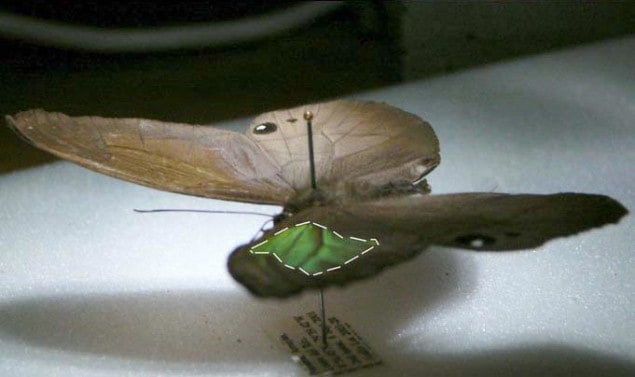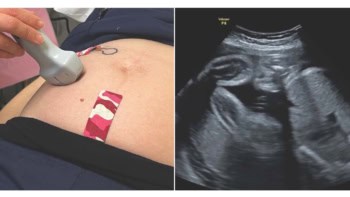
With its leafy-brown body, Pierella luna is a butterfly from the forests of Central America that appears to have nothing special about it. But when illuminated by a beam of light, the males reveal a rainbow marking on both of their forewings when viewed from certain angles.
First observed over 30 years ago, the mechanism behind this intriguing optical effect has now been described for the first time by a group of researchers in Belgium and Panama. If it could be mimicked in the laboratory, the effect might allow engineers to develop novel colour-changing surfaces.
Rainbow colouration has been noted previously in the wings of several other butterflies, and has been attributed to grooves in wing scales. These channels diffract light during reflection – much like the pits in the surface of a CD. But Pierella luna is different because its wings produce a reverse conventional colour spectrum with red light emerging almost perpendicular to a wing and blue light being almost parallel to the surface.
A flash of green
Annette Aiello, of the Smithsonian Tropical Research Institute in Panama, first spotted the rainbow effect in 1981 in the wings of a male Pierella luna as it was pursuing a female. “I could have sworn I saw a flash of green,” she recalls. Aiello went on to become the first scientist to describe the phenomenon in a publication.
Aiello has now teamed up with physicists at the University of Namur in Belgium, led by Jean Pol Vigneron, to investigate the mechanism behind the iridescence effect. The researchers collected a number of butterflies from two sites in Panama and another location in Mexico, before conducting a series of experiments.
Using scanning electron microscopy, Vigneron and his colleagues discovered an unusually stark deformation in the wings of Pierella luna, finding that the wing scales curl to form a vertical diffraction grating perpendicular to the wing surface. So rather than being reflected, light is diffracted as it passes through the butterfly’s wings with the perceived colour changing with viewing angle.
By illuminating the wings of Pierella luna from a fixed angle of 45° from the normal, Vigneron’s team observed the wing colours change from brown through to green through to blue, as their viewing angle varied from 45° through to 75° relative to the vertical.
Marking the males
It is not clear why male Pierella luna have evolved to possess this ability, but Aiello believes it is related to courting, perhaps to help males distinguish between the sexes to ensure they are “chasing” the right butterflies. “It is difficult to study because we so rarely see the males open their wings in the sunlight – they spend most of their time near the forest floor, camouflaged against the leaves,” says Aiello.
Producing an artificial version of this rainbow effect is described by the researchers as a “formidable” task, given the micro-engineering challenges. In theory, the effect could be exploited to create, say, clothes that can change colour or novelty fabrics for house interiors.
Mathias Kolle, a biological structures researcher at the University of Cambridge in the UK, believes that the effect could also be exploited in security printing to brand goods and to mark authentic bank notes from counterfeits. “This unique effect would extend the library of optical phenomena that are already exploited to create labels with unique optical signatures,” he says.
This research is described in Physical Review E.




